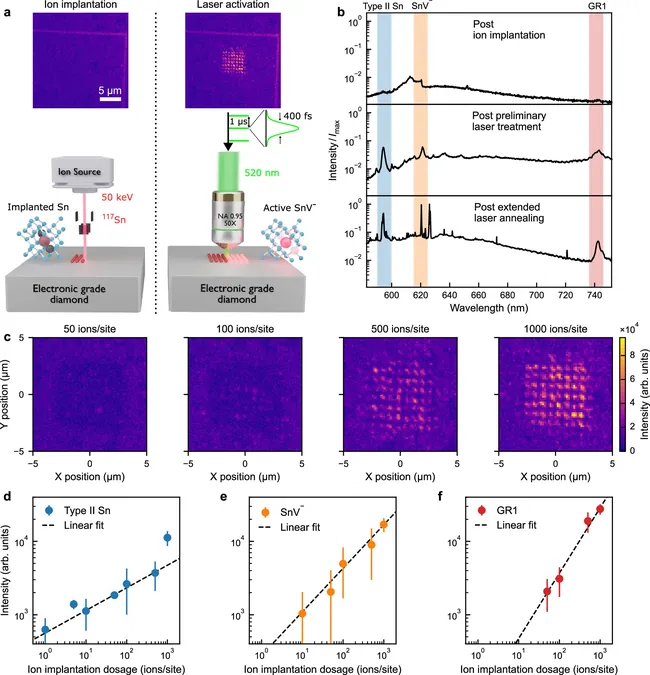
Revolutionizing Quantum Tech: How Scientists are Unlocking the Secrets of Diamond Defects
2025-06-12
Author: Arjun
A Game-Changer in Quantum Materials
In a groundbreaking study, researchers from Oxford, Cambridge, and Manchester have unveiled a revolutionary method for precisely engineering single quantum defects within diamonds. This pivotal breakthrough represents a crucial leap towards scalable quantum technologies, detailed in the latest edition of Nature Communications.
Innovative Two-Step Fabrication Method
Employing a novel two-step fabrication approach, the research team successfully created and monitored individual Group-IV quantum defects in diamonds—tiny imperfections that capitalize on the unique laws of quantum physics to store and transmit information. This remarkable achievement is a major step towards crafting robust quantum networks.
Pinpoint Accuracy with Tin Atoms
By strategically placing single tin atoms into synthetic diamond crystals and activating them with ultrafast laser pulses, the scientists gained precise control over the emergence of these quantum features. This level of accuracy is essential for constructing large-scale quantum networks, which promise ultra-secure communication and the potential to solve problems once deemed unsolvable.
Real-Time Monitoring of Quantum Creation
Professor Jason Smith from the University of Oxford expressed his enthusiasm, noting, "This breakthrough affords us unprecedented control over single tin-vacancy color centers in diamond. The ability to observe the formation of these quantum defects in real-time is fascinating!" These defects serve as spin-photon interfaces, connecting quantum bits of information stored in electrons with photons.
The Quest for Stability in Quantum Networking
Known for their exceptional symmetry, Group-IV color centers have long been coveted for their stable optical and spin properties—ideal for quantum networking. Researchers now believe that tin-vacancy centers combine the best of these properties. The challenge of reliably placing and activating individual defects has now been overcome.
Precision Like Never Before
The team utilized a focused ion beam platform, akin to an atomic-scale spray can, to accurately implant tin ions within the diamond. Achieving nanometer precision—much finer than a human hair’s width—was instrumental in their success.
Laser Annealing: A Gentle Touch
To convert these placed tin atoms into active tin-vacancy centers, the research team employed laser annealing. This technique involved using laser pulses to delicately excite parts of the diamond, while a real-time spectral feedback system provided immediate insight into the activation of defects, allowing for on-the-spot adjustments.
A Versatile Approach with Broader Applications
Dr. Andreas Thurn from Cambridge highlighted the significance of this method: "It enables in-situ control during the defect creation process, maximizing efficiency and precision for large-scale quantum networks. Not only is this method adaptable to diamonds, but it could also be extended to other wide-bandgap materials."
Discovering the Elusive "Type II Sn" Complex
The team also explored a previously elusive defect complex dubbed "Type II Sn," deepening their understanding of how defects in diamonds form and behave.
The Future of Quantum Devices is Bright
Professor Richard Curry from the University of Manchester concluded, "This research empowers us to create quantum objects on demand through reproducible, scalable methods—paving the way for real-world commercial applications of quantum technology."


 Brasil (PT)
Brasil (PT)
 Canada (EN)
Canada (EN)
 Chile (ES)
Chile (ES)
 Česko (CS)
Česko (CS)
 대한민국 (KO)
대한민국 (KO)
 España (ES)
España (ES)
 France (FR)
France (FR)
 Hong Kong (EN)
Hong Kong (EN)
 Italia (IT)
Italia (IT)
 日本 (JA)
日本 (JA)
 Magyarország (HU)
Magyarország (HU)
 Norge (NO)
Norge (NO)
 Polska (PL)
Polska (PL)
 Schweiz (DE)
Schweiz (DE)
 Singapore (EN)
Singapore (EN)
 Sverige (SV)
Sverige (SV)
 Suomi (FI)
Suomi (FI)
 Türkiye (TR)
Türkiye (TR)
 الإمارات العربية المتحدة (AR)
الإمارات العربية المتحدة (AR)